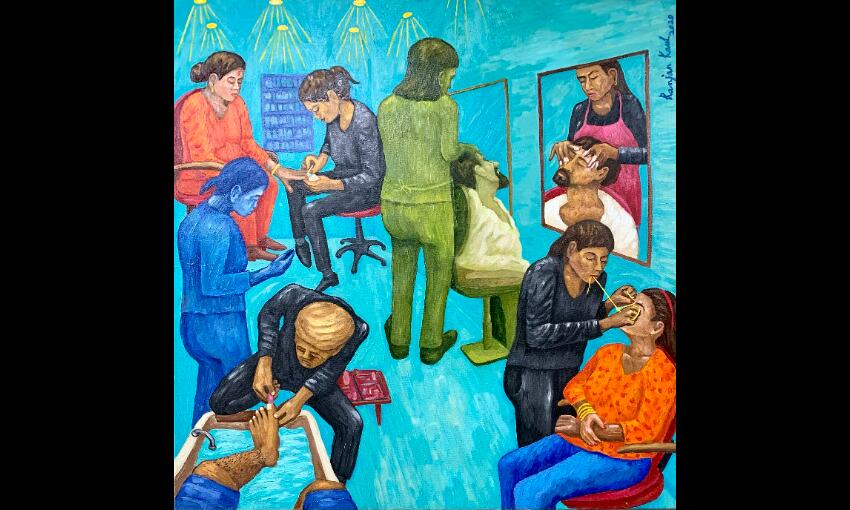Global art in flux

Ranjan Kaul is a Delhi-based self-taught visual artist. He started painting formally when he was 26 years. After completing his B. Tech from IIT, he did post-graduate studies in design and literature and took up book publishing as a career. Alongside, he painted and wrote fiction whenever he could find the time. As the managing director of Oxford University Press, India, he left publishing about seven years ago to pursue art full time. His work has been exhibited at prestigious art galleries such as the Lalit Kala Akademi, the Indira Gandhi National Center for the Arts (IGNSA) and the M.F. Hussain Art Gallery among other venues.
Millennium Post's Ravi V. Chhabra spoke with him at length on various facets of art.
Artists and painters are considered to be somewhat cynical and moody. Your take?
Moody yes, cynical may be, but not in my case. I'm an optimist but I do find some things around us disturbing.
What medium do you use and where is your studio?
I work with various mediums – water colour, pastels, oil, acrylic and mixed media. I've a studio is in Delhi and another in the Shimla hills.
Is there a relation between art and pain?
Pain, loss, suffering often manifests in art. Such emotions have given birth to timeless art. For example, take Vincent Van Gogh when he faced rejection in love.
How has the art world been impacted by Covid and the ongoing Russian-Ukraine war?
Covid-19 caused a huge disruption with buyers and collectors of art, as they were unable to see the works physically. The venues were shut down. While galleries did try to make up through online exhibitions, their success was limited. extent. However, at the same time, NFT (Non Fungible Token) got a major fillip with the sale of the digital art of Mike Winkelmann (known as Beeple), for a staggering $69.3 million. The pandemic also led to creation of moving works, in relation to isolation, loss, plight of migrant workers.
The Russian-Ukraine warhas been a major blow to artists around the world. Ukrainian and Russian art and artists have been most affected. Many Russian galleries have shut down. While some Russian artists have fled the country, some others have stayed behind to do protest art. At the International Venice Biennale in April, while Ukrainian artists sent out a strong message, the Russian artists pulled out as a sign of protest, leaving the Russian pavilion empty.
At 'artamour', an online forum, you have featured some international artists. What was the objective?
Yes, we have featured artists from the US, UK, Sri Lanka, Russia and the Philippines and also reviewed international exhibitions. The idea is to familiarize Indian readers with world art, and at the same time, offer a platform to Indian artists for global reach.
Which genre of art is more in demand commercially – figural, landscape, or abstract?
Figural art has seen a resurgence and is most in demand internationally, though landscapes and other genres of art are thriving too. However, abstract art is dying in the West though in India the genre still remains popular.
Do we see a convergence in forms of art like storytelling on the canvas?
Indeed, plenty is happening in contemporary art. Besides including narratives in painting, art is become increasingly diverse, multi-disciplinary and collaborative, with artists working together in small groups as art collectives. Besides digital art, technology and AI (Artificial Intelligence) are also coming into play.
If you were to name 5 each of your favourite contemporary painters internationally and in the Indian landscape?
Among the international names, my favourites are: Alex Katz, Michael Armitage, Aliza Nisanbaum, Salman Toor and Kara Walker. Of the Indian artists, I like the works of the following in no particular order: Shilpa Gupta, Nikhil Chopra, Jittish Kalat, Ghulam Mohammed Sheikh, and Atul Dodiya.
How much is the curator's contribution to an exhibition/museum/ gallery?
A lot. The curator not only works on the display and lighting but also lays down the thematic for a show and plays a crucial role in the selection of artists and their works.
Your views on the proliferation of wall art in India and does it augur well for the artists/painters?
This is a welcome development. While it brings art closer to the public, it also gives sustenance to young, struggling artists. However, the art that we get to see on Indian urban walls is more decorative or folk art rather than contemporary. For instance, a group of professionally trained Kerala artists called "Trespassers" have been creating murals by involving village communities. World over, wall / street art is seeing considerable innovation, including 3D art and protest graffiti art.
Which country has biggest demand in figurative?
Well, without second thought, it's the US.
Your favourite medium for painting?
Oil on canvas.

